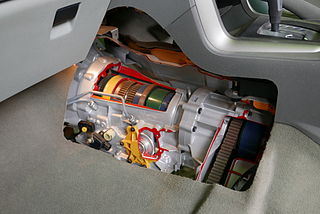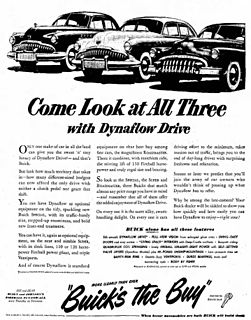
An automatic transmission, also called auto, self-shifting transmission, n-speed automatic, or AT, is a type of motor vehicle transmission that can automatically change gear ratios as the vehicle moves, freeing the driver from having to shift gears manually. Like other transmission systems on vehicles, it allows an internal combustion engine, best suited to run at a relatively high rotational speed, to provide a range of speed and torque outputs necessary for vehicular travel. The number of forward gear ratios is often expressed for manual transmissions as well.

A transmission is a machine in a power transmission system, which provides controlled application of the power. Often the term transmission refers simply to the gearbox that uses gears and gear trains to provide speed and torque conversions from a rotating power source to another device.

A manual transmission, also known as a manual gearbox, a standard transmission or colloquially in some countries as a stick shift, is a type of transmission used in motor vehicle applications. It uses a driver-operated clutch, usually engaged and disengaged by a foot pedal or hand lever, for regulating torque transfer from the engine to the transmission; and a gear selector that can be operated by hand or foot.
A semi-automatic transmission is an automobile transmission that combines manual transmission and automatic transmission.

Hydramatic is an automatic transmission developed by both General Motors' Cadillac and Oldsmobile divisions. Introduced in 1939 for the 1940 model year vehicles, the Hydramatic was the first mass-produced fully automatic transmission developed for passenger automobile use.

TorqueFlite is the trademarked name of Chrysler Corporation's automatic transmissions, starting with the three-speed unit introduced late in the 1956 model year as a successor to Chrysler's two-speed PowerFlite. In the 1990s, the TorqueFlite name was dropped in favor of alphanumeric designations, although the latest ZF-based transmissions with the 8-speed automatic has revived the name.

Dynaflow was the trademarked name for a type of automatic transmission developed and built by General Motors Buick Motor Division from late 1947 to mid-1963. The Dynaflow, which was introduced for the 1948 model year only as an option on Roadmaster models, received some severe early testing in the M18 Hellcat tank destroyer, which were built in Buick's Flint, Michigan assembly plant during World War II. It was also used in the 1951 Le Sabre concept car.
Ford-O-Matic was the first automatic transmission widely used by Ford Motor Company. It was designed by the Warner Gear division of Borg Warner Corporation and introduced in 1951 model year cars. In contrast to Detroit Gear Division's three band automatic originally designed for Studebaker which became superseded by this unit, a variation of Warner Gear's three-speed unit named Ford-O-Matic continued to evolve later into Cruise-O-Matic named transmissions in 1958 and finally the FMX named transmissions in 1968. This line continued in production until 1980, when the AOD was introduced. Like Ford, variations of this same Borg Warner design were used by other automobile manufacturers as well, such as AMC, International Harvester, Studebaker, Volvo and Jaguar, each of them having the necessary unique adaptations required for the individual applications.
7G-Tronic is Mercedes-Benz's trademark name for its seven-speed automatic transmission. This fifth-generation transmission was introduced in the Autumn of 2003 on 8-cylinder models, and was the first seven-speed automatic transmission ever used on a production passenger vehicle.
Toyota Motor Corporation's U family is a family of automatic FWD/RWD/4WD transmissions found in later vehicle models.
The Hondamatic was Honda's first automatic transmission. It was produced from 1973 through 1988. The Hondamatic name continued to be used on fully automatic transmissions from Honda.
A sequential manual transmission is a non-traditional type of manual transmission used on motorcycles and high-performance cars for auto racing, where gears are selected in order, and direct access to specific gears is not possible.
The Aisin AW TF-8# SC series is a 6-speed automatic transmission designed for use in transverse engine applications and produced by Aisin Seiki. It is designed to handle a maximum of 440 N⋅m (324.5 ft⋅lbf) of torque. It is built in Anjō, Japan. It is also called the TF-80SC and TF-81SC (AF21).
The Simpson planetary gearset consists of two planetary gearsets, both having the same gears and gear ratios. It was employed in automatic transmissions. It was one of the several designs invented by American engineer Howard Simpson. A Simpson gearset delivers three forward gears and one reverse, plus neutral. Actually there are four forward gears, but two of them have exactly the same ratio, so there are three distinct gears. Third gear is always direct drive (1:1).
The ZF 9HP is a nine-speed automatic transmission built by ZF Friedrichshafen AG subsidiary ZF Transmissions in Gray Court, South Carolina. It is a front-transverse transmission, used in front-wheel drive and all-wheel drive vehicles. ZF claims that it is able to save an average of 16% in fuel compared with current 6-speed automatic transmissions. The gear ratio spread is 9.81:1. The transmission has a torque range between 280 and 480 Nm.
9G-Tronic is Mercedes-Benz's trademark name for its nine-speed automatic transmission. This transmission was introduced in 2013. It is the world's first nine-speed transmission. It was first used in the Mercedes-Benz S-Class (W222), and it has been expanded to be used in the Mercedes-Benz C-Class (W205) and the sedan and wagon variants of the Mercedes-Benz E-Class (W213). This transmission was later introduced on Mercedes-Benz M-Class (W166) facelift on the GLE250d model. V12 engine models continue to use the older Mercedes-Benz 7G-Tronic transmission. Wide ratio spread of 9.30:1.
The Mercedes-Benz first series of automatic transmission, designated with series model numbers 722.0, 722.1 and 722.2, is a family of three and four-speed automatic transmission for engines with longitudinal layout for rear wheel drive passenger cars.







